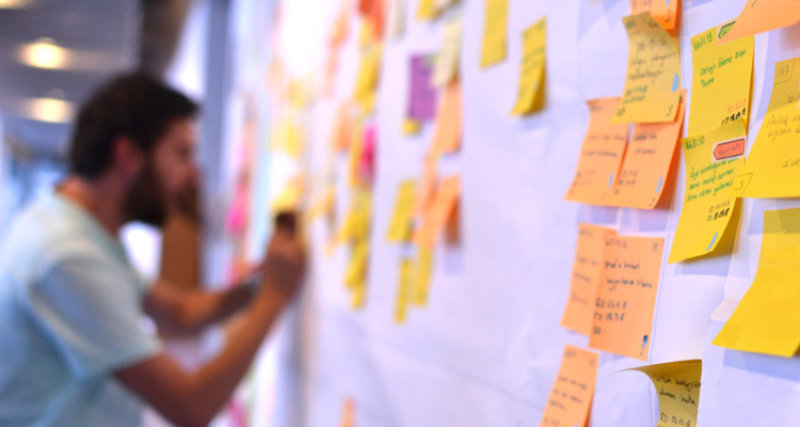
My name is Amber Bartlett and I’m an Education Specialist at Planview AgilePlace. I have the pleasure of working with customers as they begin implementing our tool. One question that I get fairly regularly has to do with how many boards one person should have. Should each project get its own board, or is there a better way?
In concept, having a board for each project sounds logical. Each board would be so tidy! The cards on each board would all be about one thing, so you wouldn’t have to wade through unrelated material to find what you need. At the end of each project, you can neatly tuck each board into the archive, and start the next project on a fresh, new board. This is how project managers have been doing things for years.
However, doing things the “way we’ve always done it” is hardly a step in the direction of continuous improvement. If you manage this way, are you truly making steps towards becoming the Lean company that you are working to be?
The essential Lean principle Eliminate Waste says that we should be on a mission of continuous improvement (kaizen), driven by a very specific definition of waste: anything that a customer wouldn’t willingly pay for. Using that definition, spending time every day piecing together project status information from several project boards is an incredibly wasteful process. Continue reading to learn why you should switch to team, instead of project, Kanban boards.
Making (Inefficient) Lists, Checking Them Twice
Imagine that you are going to the grocery store to shop for a week’s meals. Instead of making a list of all the ingredients that you will need, you bring seven recipes with you — two written down on note cards, three saved as notes on your phone, and two that you have memorized (more or less). In each aisle, you have to refer to seven different places to make sure you have everything in your basket that you need.
By the end of your shopping trip, you are exhausted and tired. Oh! And you’ve forgotten to buy the chicken for Tuesday night’s meal, and you ended up getting double the amount of bread that you needed.
Using a new Kanban board for each project has a similar effect: You may need to check three or four (or more) different boards to be sure that you’ve accomplished everything you needed to do for the day. It’s possible to get everything taken care of, but it’s a far cry from efficiency — this complicated process introduces waste into the system and slows down your team’s ability to deliver value to your customers.
Think of how much more efficient it would be for everyone on your team to go to one team Kanban board — or how much less frantic (and more efficient) that grocery trip might have been if you had consolidated all your recipes into one grocery list. With one shared team Kanban board, you have everything required to make informed decisions, like which work to prioritize first. You also have the ability to collect valuable metrics to analyze your team’s performance, which is a key component of continuous improvement. This isn’t just a matter of convenience — it’s a matter of Leanness. I’ll walk through the most relevant Lean principles to explain how project boards prevent teams from truly practicing continuous improvement.
Optimize the Whole
One of the most basic tenets of Lean is Optimize the Whole. This is difficult, if not impossible, to do without a single, shared view of what the team is facing. It’s nearly impossible to track your entire team’s capacity when you have to go to multiple places to understand what each team member is committed to doing — and that’s not a good use of anyone’s time. How can you manage team WIP (Work in Process) if you don’t visualize all team activity in one place?
Create Knowledge
Another key Lean principle is Create Knowledge. If you only work within your specialty, you’re missing valuable opportunities for cross-training from your talented team members.
It’s astonishing what a fresh set of eyes can bring to a seemingly unsolvable problem. I don’t know how many times it’s happened: I couldn’t solve a problem, then after collaborating with a coworker, I was able to see it in a new light and find the right solution. Each time this happens is an incredible opportunity to grow — by hearing new ideas, and gaining more perspective on the multiple approaches to solving any given problem.
Conversely, your perspective could be equally valuable to the work someone else is doing — but without visibility into that work, you’d never see that opportunity to help your team deliver value faster. Keeping individual projects separate hides opportunities to “swarm” around problems. Fun fact: When bees need a new hive, they stop what they are doing and tackle the challenge as a system — known in the Lean/Kanban world as stopping the line. They all leave the hive in a giant bunch, keeping the queen safe in the middle. All the worker bees (minus a few scouts) stick together until a new location can be found, then they all travel together in a giant mass until the queen can be safely deposited in her new home.
How does this apply to you? When a problem arises, everyone that has visualization into the issue can drop everything and work toward a solution. The addition of new ideas, brains and hands on a problem can move a problem towards a speedy conclusion. However, without being able to visualize that there is a problem, the chance to pull together as a team may be lost. These opportunities are difficult to see without methodical visualization techniques.
Respect for People
Finally, let’s talk about my favorite principle of Lean: Respect for People. There’s nothing more disrespectful than wasting someone’s time. Unfortunately, sometimes we do this unintentionally. Before I started practicing Lean and Kanban, I didn’t see just how wasteful, and thereby disrespectful, status meetings could be. In teams I’ve been on, everyone would go around the room, waiting for their five minutes to talk. When my turn came, I would tell all my disinterested co-workers about the minutiae of my work day.
We didn’t talk about how to improve the quality of a piece of work, remove obstacles out of each other’s way or swarm on a project to get it done. We weren’t actually talking to each other — we were talking at each other.
If we don’t improve the quality of our communication (within and outside of meetings), we can’t improve the quality of our work, or the quality of our lives. How frustrating is it to feel like you’re always on a different page from your co-workers? Inevitably, miscommunications cause frustration, anxiety and resentment in teams. As W. Edwards Deming said, “A bad system will beat a good person every time.”
How Team Kanban Boards Can Help
Having your entire team’s work on one board eliminates these communication problems. Humans are visual by nature — using one Kanban board to visualize the team’s entire process enables you to spend meeting time more intentionally, focusing on the work that needs discussion (looming deadlines, critical priority or even completely blocked) instead of poorly communicated verbal status updates.
Our executive team at Planview AgilePlace completes their standup meetings in just four minutes. Of course, not every team can handle a meeting that quick, but could we eliminate hour-long status meetings, and replace them with 15-minute standups? With team Kanban boards, definitely.
Transitioning to Team Boards
So, how do you get started? Take the plunge! It can be intimidating to transition your team to a new way of visualizing work, but have no fear. We have some resources that will help you along the way.
Use our Kanban Roadmap to help design the way your work flows. This ebook can help you make decisions of the proper way to begin and to continually improve along the way. Concerned about clutter on your board? Please refer to this article, written by a member of our support team about how to effectively use filters. You’ll have a neat and tidy view of what you need to see, regardless of how many cards your team chooses to add.




